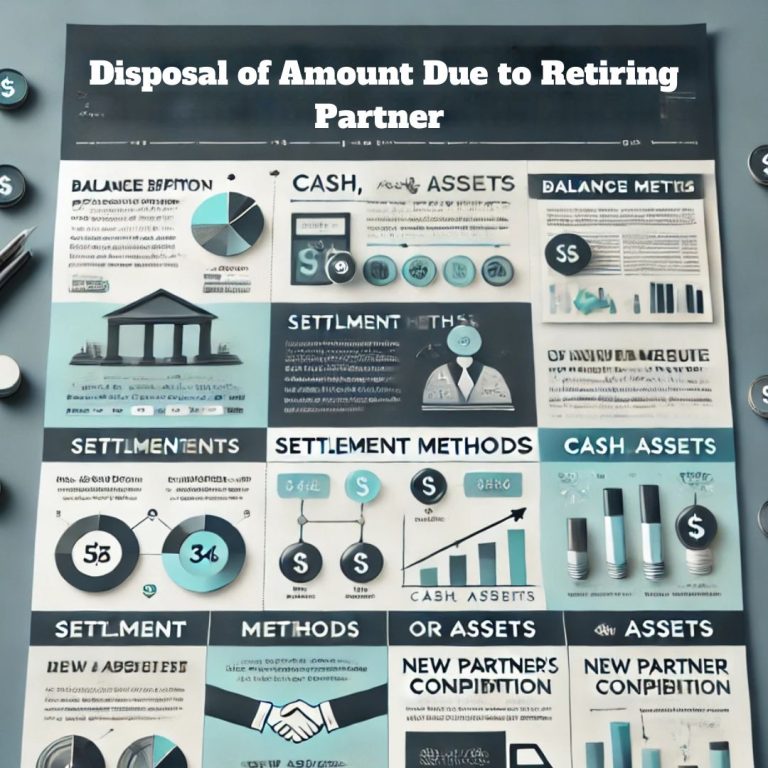The disposal of amount due to retiring partner is a critical aspect of partnership agreements, particularly when a partner decides to exit the business. This process involves settling the retiring partner’s financial entitlements, which includes their share of the partnership’s assets, liabilities, and any accumulated profits or losses. The amount due to a retiring partner must be calculated and settled in accordance with the partnership agreement or mutual consent. In this article, we will explore the methods, steps, and legal considerations involved in the disposal of such amounts to the retiring partner.
Introduction to Disposal of Amount Due to Retiring Partner
The disposal of amount due to retiring partner involves the payment or transfer of financial assets that the retiring partner is entitled to based on the partnership’s valuation at the time of their exit. This amount typically includes the partner’s capital account balance, their share of retained earnings, and their proportionate share of the business’s goodwill. The exact amount due to the retiring partner can vary based on the terms of the partnership agreement, the financial health of the business, and the method chosen to value the partnership’s assets. Properly managing the disposal is vital to ensure fair treatment of the departing partner and avoid any potential legal disputes.
The process of settling the amount due to the retiring partner generally includes several steps, such as valuing the partner’s share, adjusting for liabilities, and determining how the payment will be made. All of these aspects must be done carefully to ensure that the transition is smooth and equitable.
Methods of Valuing the Retiring Partner’s Share
Valuation of the retiring partner’s share is a crucial step in the disposal of amount due to retiring partner. Several methods can be used to determine the amount owed to the retiring partner, depending on the nature of the business and any agreements in place.
1. Book Value Method
This is one of the most straightforward methods for valuing the partner’s share. It involves calculating the book value of the partnership’s assets and liabilities. The retiring partner is entitled to their proportionate share of the net assets (assets minus liabilities).
- Example: If the total net assets of the partnership are $100,000 and the retiring partner holds a 40% share, their amount due would be $40,000.
2. Fair Market Value (FMV) Method
In this method, the assets are valued at their current market value, rather than their book value. This is useful when the business has assets that have appreciated or depreciated in value since the last financial statement.
- Example: If the partnership owns real estate that has appreciated in value, the retiring partner’s share would be based on the current market value, not the book value recorded in the accounting records.
3. Goodwill Method
Goodwill represents the intangible value of the partnership, such as customer relationships, brand reputation, or business location. The goodwill method involves calculating the value of the partnership’s goodwill and allocating a share of it to the retiring partner.
- Example: If the partnership has goodwill valued at $50,000 and the retiring partner owns 30% of the business, their share of the goodwill would be $15,000.
4. Negotiated Method
In some cases, the partners may agree on a value based on negotiation, rather than strictly using one of the methods above. This method relies on mutual agreement and may take into account factors like future profitability, contributions to the business, or other subjective factors.
- Example: The partners may agree that the retiring partner’s share is worth $60,000 based on their unique contribution to the business, even though the book value or FMV calculations suggest a lower amount.
Steps Involved in Settling the Amount Due
Once the retiring partner’s share has been valued, the next step is to settle the amount due to them. This involves several key steps to ensure that the process is fair and transparent.
1. Review the Partnership Agreement
The first step in settling the amount due is to review the partnership agreement, as it may outline specific procedures for a partner’s exit. The agreement should specify how the retiring partner’s share is to be valued and how payments are to be made.
- Example: The partnership agreement may state that a retiring partner’s share should be calculated based on the FMV method, with payments to be made in installments over a set period.
2. Calculate the Final Amount Due
Once the valuation method is agreed upon, the total amount due to the retiring partner must be calculated. This may involve adding up the partner’s capital balance, their share of accumulated profits, and any other entitlements such as a share of goodwill.
- Example: If the retiring partner is entitled to $40,000 in capital and $10,000 in accumulated profits, the total amount due would be $50,000.
3. Settle Liabilities
Before paying out the amount due, the partnership may need to settle any outstanding liabilities, such as debts or obligations. This ensures that the retiring partner’s share is calculated based on the business’s net worth, rather than its gross value.
- Example: If the partnership has a $20,000 outstanding loan, the retiring partner’s share will be adjusted to reflect the net value after subtracting the loan.
4. Pay the Retiring Partner
Once the calculations are complete, the payment method must be determined. This could include a lump-sum payment, installment payments, or transferring assets.
Mode of Payment to the Retiring Partner
The mode of payment to the retiring partner can vary, and it is essential to choose an option that works for both the business and the retiring partner. Common payment methods include:
1. Lump-Sum Payment
In many cases, the retiring partner receives a lump-sum payment for the full amount due. This is the simplest and quickest method but may not always be feasible if the business does not have enough liquidity.
- Example: The retiring partner receives the full $50,000 owed to them in a single payment.
2. Installment Payments
If the partnership cannot afford to pay the entire amount at once, they may agree to pay the retiring partner in installments over a set period. This is often outlined in the partnership agreement.
- Example: The retiring partner might agree to receive $10,000 annually for five years until their total amount due is paid off.
3. Transfer of Assets
In some cases, the partnership may offer the retiring partner assets instead of cash. This could include property, shares, or other valuable assets that are part of the business.
- Example: If the partnership owns real estate, the retiring partner may receive a share of the property as part of their settlement.
Tax Implications and Legal Considerations for Retiring Partners
There are several tax and legal implications involved in the disposal of amount due to retiring partner. Understanding these considerations is vital to avoid potential legal issues or financial penalties.
1. Taxation of Capital Gains
In some jurisdictions, the transfer of assets to the retiring partner may be subject to capital gains tax. This is particularly relevant when assets are being transferred as part of the settlement.
- Example: If the business sells assets to pay the retiring partner, any profits made from the sale could be subject to capital gains tax.
2. Partnership Dissolution
If the retiring partner’s exit results in the dissolution of the partnership, the business may need to go through a legal dissolution process. This may involve filing with relevant authorities and settling outstanding debts.
- Example: If the partnership is being dissolved, the remaining partners must agree on the distribution of assets and liabilities according to the partnership agreement.
3. Tax Treatment of Installment Payments
If the retiring partner is paid in installments, the tax treatment of these payments may differ from a lump-sum payment. Installment payments may be taxed as income in the year they are received.
- Example: If the retiring partner receives $10,000 per year in installment payments, each payment may be subject to income tax in the year it is received.
Conclusion
The disposal of amount due to retiring partner is a complex process that requires careful planning and adherence to legal and financial guidelines. It involves accurately valuing the retiring partner’s share, following the steps for settling the amount due, and choosing an appropriate method of payment. Additionally, tax and legal implications must be considered to ensure compliance and avoid future complications. By following the correct procedures, partnerships can ensure that the transition is smooth and fair for all parties involved.
Disposal of Amount Due to Retiring Partner FAQs
How is the amount due to a retiring partner calculated?
The amount due is calculated based on the value of the retiring partner’s share in the partnership, which includes their capital balance, accumulated profits, and share of goodwill.
What are the common methods for valuing the retiring partner’s share?
Common methods include book value, fair market value, goodwill valuation, and negotiated methods.
What is the best way to settle the amount due to a retiring partner?
The best way depends on the partnership’s financial situation and the agreement between partners. Common methods include lump-sum payments, installment payments, or transfer of assets.
Are there any tax implications when settling a retiring partner’s share?
Yes, there may be capital gains tax on asset transfers and income tax on installment payments. It’s important to consult with a tax advisor to understand specific tax liabilities.
Can the retiring partner demand a lump-sum payment?
A lump-sum payment may be requested, but it depends on the partnership agreement and the business’s ability to pay. Installment payments are also a common option.


